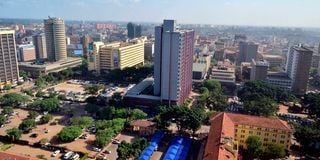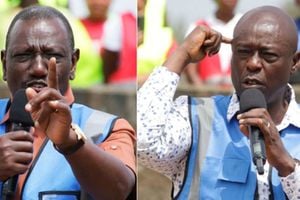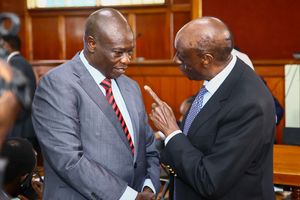Nairobi among three counties flagged for inaction on climate change

An aerial view look of Nairobi City pictured on December 18, 2020.
The National Treasury, through a World Bank-funded project, has raised concern over the absence of climate resilience activities in Nairobi, Kiambu and Mombasa Counties, a situation that has caused the three counties to miss out on adaptation funding.
According to the Treasury, the three counties have failed to put in place a climate change action, have not dedicated at least 1.5 percent of their development budgets to climate adaptation and have also failed to undertake a Participatory Climate Risk Assessment (PCRA) at the ward level. These, the Treasury says, are the key requirements in order to qualify for the Financing Locally Led Climate Adaptation (FLLoCA), funded by the World Bank.
“44 out of the 47 counties have met these requirements and will now move to the next phase of the financing, where they will receive grants to climate-proof their communities,” said Peter Odhengo, the head of climate finance and green economy at the Treasury and also the head of the FLLoCA programme.
“In the first phase, the 44 counties received 22 million shillings each as an institutional support grant, to enable them lay the groundwork. One of the things they were to do is set up ward climate committees which would then document the climate risks in the respective wards, what the needs are and therefore design a ward-specific action plan,” he said.
In 2021, Kenya signed a Sh100 billion deal with the World Bank at COP 26 in Glasgow.
Finance adaptation activities at the grassroots level through the county governments. Ninety per cent of the funding was targeted for spending at the county and community levels to ensure that support for climate resilience reaches those most at risk, including women, youth, persons with disabilities, elders, and other traditionally marginalized groups. The remaining 10 per cent was to cover the administrative costs.
At that time, only 33 counties had created climate funds within their development budgets and also had local climate laws.
“The local climate laws are basically adaptation plans at the county level and under this programme, we strive to ensure that what is contained in those plans reflects the views of the people on the ground,” Odhengo said.
Given that agriculture is the backbone of the country as well as the vast majority of the counties, most of the county plans centre around climate-smart agricultural activities, such small-scale irrigation and the adoption of drought-resilient seeds.
“For example, investments may focus on activities that support livelihood diversification, or community-level preparedness for multiple risks. Depending on what communities prioritize, investments may also promote water conservation and more efficient use of water, support natural resource management, rehabilitate degraded lands, or promote early warning systems,” the World Bank said during the launch of the programme in Glasgow.
In the next phase of funding, the 44 counties that have qualified will now be eligible for grants to implement their adaptation plans. These grants will range between 100 and 150 million.
“We have written to Nairobi, Mombasa and Kiambu to inquire about their inaction, but we have not received any responses. We cannot compel them to comply, though. It is the people in those counties who can compel their county governments to take action on climate change. In Nairobi for instance, we had hoped to see the county drive some action towards climate-proofing slums because they are very vulnerable,” Odhengo added.
The money for the next phase of FLLoCA has already been released from the World Bank accounts and is sitting in the FLLoCA accounts at the treasury, awaiting dispatch once the assessment is complete.
FLLoCA was designed to build on the Kenya Accountable Devolution Programme, which was also funded by the World Bank. It also builds on the work done by the Adaptation Consortium through the County Climate Change Funds that were set up in Isiolo, Garissa, Kitui, Makueni and Wajir.





